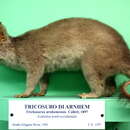en
names in breadcrumbs


Perception Channels: tactile ; chemical
Trichosurus arnhemensis is considered a lower risk, near threatened species by the IUCN.
US Federal List: no special status
CITES: no special status
The Northern Brushtail Possums negatively affect the human populations that they live around in a number of different ways. They often damage flowers, fruit trees, and buildings. They also adversely affect regenerating forests. These animals are also known to carry diseases that are harmful to humans and livestock (Nowak, 1999).
Negative Impacts: crop pest; causes or carries domestic animal disease
T. arnhemensis eats a variety of foods. The most common are leaves, buds, flowers, and fruits. It has been documented that, occasionally, birds are eaten (Nowak, 1999).
Animal Foods: birds
Plant Foods: leaves; fruit; flowers
Primary Diet: herbivore (Folivore , Frugivore )
Trichosurus arnhemensis is closely related to Trichosurus vulpecula, with its most distinguishing feature being its geographic range. It is found in the Northern Territory of Australia, as well as in the extreme northern part of Western Australia. It is also found on Barrow Island (Nowak, 1999).
Biogeographic Regions: australian (Native )
The Northern Brushtail Possum is able to live in a variety of habitats, including residential areas, forests, and areas without trees that offer caves and burrows for shelter. The most common of these is wooded areas.
Habitat Regions: tropical
Terrestrial Biomes: forest ; scrub forest
The expected lifespan is 11 to 13 years.
Range lifespan
Status: wild: 11 to 13 years.
The body length is between 35 cm and 55 cm. The tail adds an additional 25 cm to 40 cm. Females weigh between 1500 g to 3500 g and males weigh between 2000 g and 4500 g. The coat is typically grey in color; however, it can also be reddish brown, copper, or chocolate brown. The fur is shorter and less dense than that of the closely related T. vulpecula (Kerle, 1991). The tail is prehensile and covered with fur. The underside is hairless. The tail of the T. arnhemensis is less hairy and thinner than the tail of T. vulpecula (Kerle, 1991). The ears are long and oval.
Range mass: 1500 to 4500 g.
Range length: 35 to 55 cm.
Other Physical Features: endothermic ; bilateral symmetry
Known Predators:
Gestation lasts between 17 and 18 days. The pouch period lasts 4 to 5 months. There is generally one offspring per birth. Weaning takes between 6 and 7 months. Individuals reach sexual maturity around age 1 and breed continuously throughout the year. Conception takes place before fully weaning the pouch young. If the pouch young is lost, the female returns to estrus in about 10 days (Nowak, 1999).
Average number of offspring: 1.
Range gestation period: 17 to 18 days.
Range weaning age: 6 to 7 months.
Average age at sexual or reproductive maturity (female): 1 years.
Average age at sexual or reproductive maturity (male): 1 years.
Key Reproductive Features: year-round breeding ; gonochoric/gonochoristic/dioecious (sexes separate); sexual ; fertilization (Internal )
Average number of offspring: 1.
The northern brushtail possum (Trichosurus arnhemensis) is a nocturnal marsupial inhabiting northern Australia. The northern brushtail possum is sometimes considered a species,[1] however more often than not is considered a subspecies of the common brushtail possum (Trichosurus vulpecula arnhemensis).[2][3]
Possums are nocturnal in nature, so feed between dawn and dusk. They are territorial creatures and can be found alone or in family groups.[4]
Its fur is a grey in colour, with a white underbelly and pink skin. The northern brushtail possum can grow up to 55 cm (22 in) in length, not including its tail, and is around the size of a small cat. Unlike its relatives and despite what its name suggests, the northern brushtail possum does not have a bushy tail.[5][6]
The northern brushtail possum breeds year-round, with a gestation period around 17–18 days and pouch period of 4–5 months. It can live up to 15 years.
Many of the NT possums are found to have contracted a flesh eating bacteria. This causes their faces to be eaten away and often results in blindness. The disease has been widely spread within the possum community, also affecting Ringtail possums. Possums brought into the local RSPCA after contracting the disease are commonly put down. Once the possums contract the sickness they are often found to be more welcoming to humans, and will approach when practical.[7]
The northern brushtail possum is well adapted to rural and urban areas and is sometimes considered a pest when found in high numbers.[6] Like other possums, it is rather tolerant of humans and can sometimes be hand fed, although it is not encouraged, as its claws are quite sharp and can cause infection or disease to humans if scratched.
It is a traditional food source for some Indigenous Australians.[8] In the Kunwinjku language it is known as djebuyh.[9][10] According to Reverend P. Nganjmirra, Kunwinjku elder, it tastes "good".[11] It is cooked in a hole like bandicoot.
The northern brushtail possum eats a variety of plant matter, including fruit, leaves, flowers, and seeds.[5] Brushtail possums are known to be tolerant of many plant toxins and can eat tree leaves that other animals find poisonous. Possums also eat insects, moths, grubs, snails, birds’ eggs, and chicks. Many of the possums' favourite foods are unfortunately found in domestic gardens, drawing the possums into residential yards.[4]
 A male northern brushtail possum eating an apple
A male northern brushtail possum eating an apple The northern brushtail possum (Trichosurus arnhemensis) is a nocturnal marsupial inhabiting northern Australia. The northern brushtail possum is sometimes considered a species, however more often than not is considered a subspecies of the common brushtail possum (Trichosurus vulpecula arnhemensis).